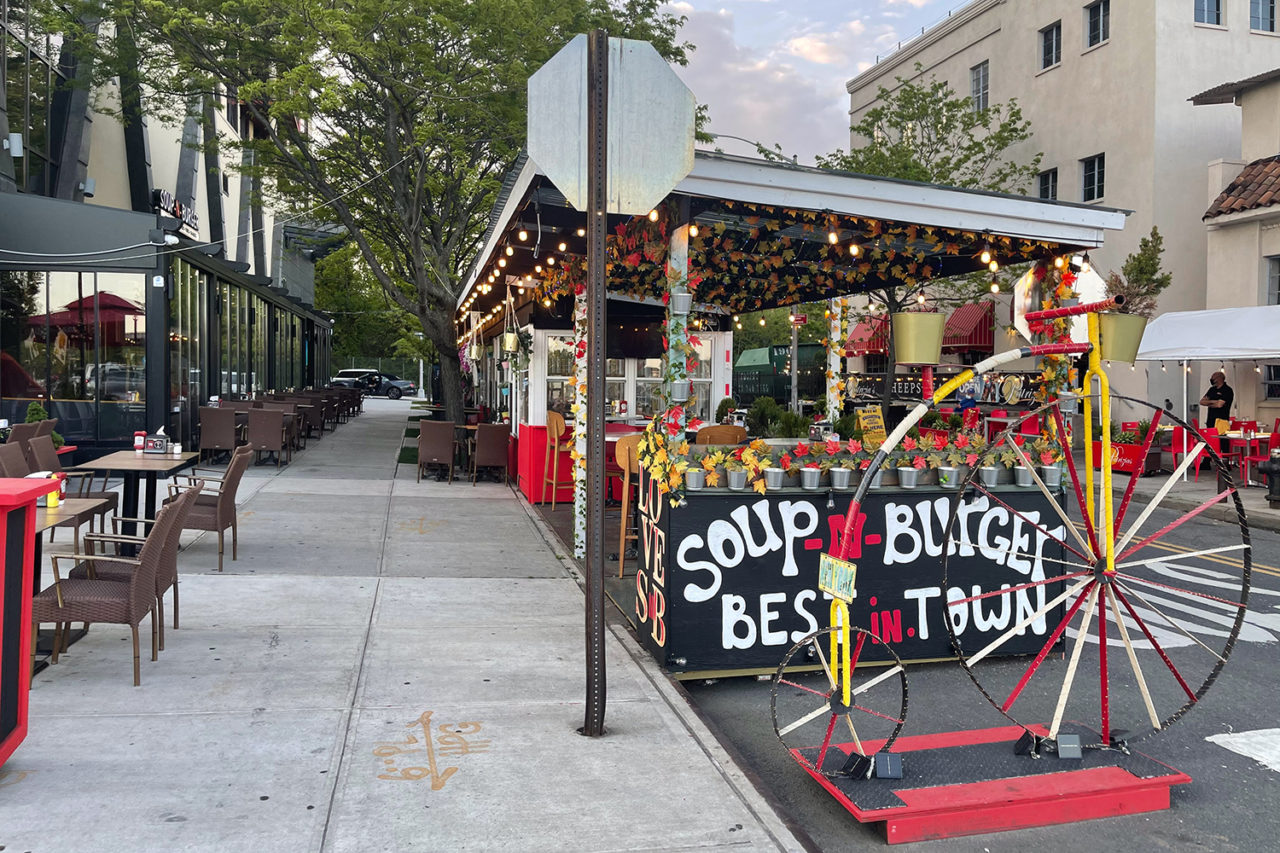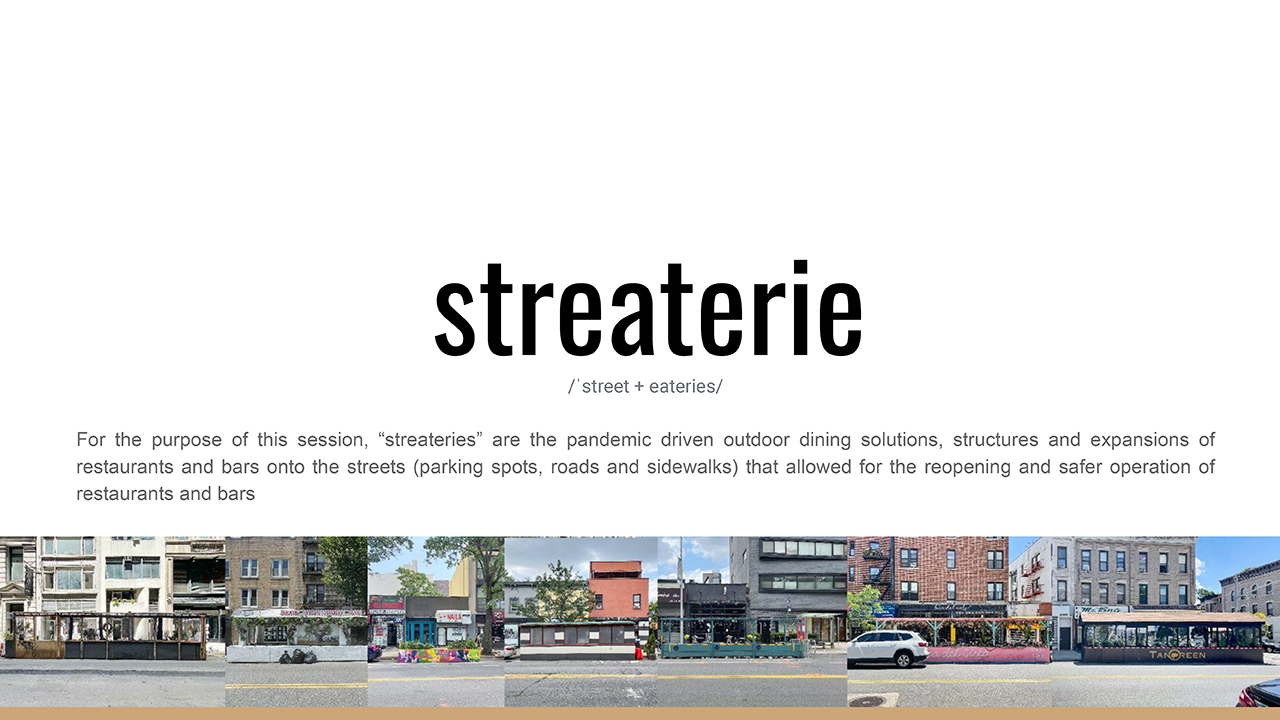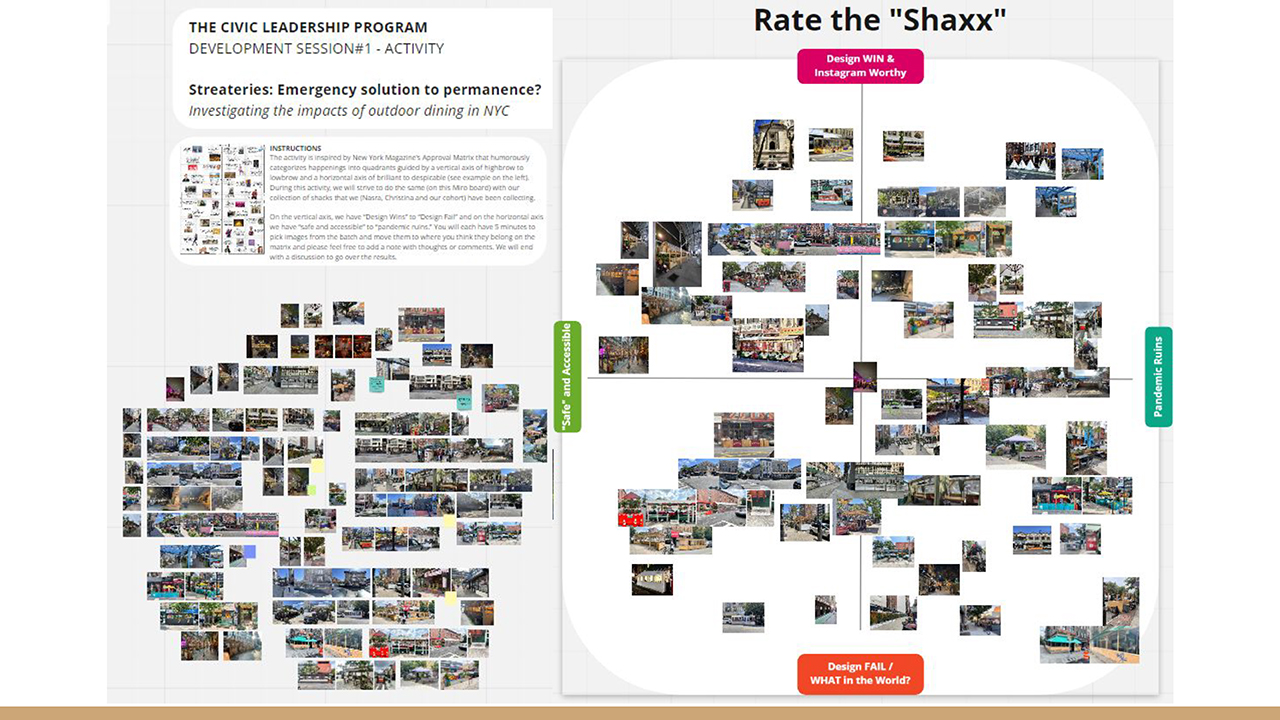by: Christina Brown, Assoc. AIA, and Nasra Nimaga, AIA, NOMA
On Friday, July 23, the 2021 class of the AIANY Civic Leadership Program (CLP) convened for their first remote development session, organized by Christina Brown, Assoc. AIA, and Nasra Nimaga, AIA, NOMA. The session focused on the transition of outdoor dining structures from an emergency temporary response to the COVID-19 pandemic to more permanent structures. Following the outbreak of the pandemic, outdoor dining structures (also known as “Streateries”) were quickly implemented to allow for safer operations by extending dining outdoors; in a matter of weeks, we saw the emergence of a new pop-up typology.
The development session brought together various voices to explore the challenges and impacts of outdoor dining structures: their efficiencies and inefficiencies, their inequities, and the implications of their potential permanence in our city. As these structures continue to be a part of our city’s landscape, what are the priorities for restaurant owners and workers, designers, public agencies, health experts, and the public? How can we take advantage of this pivotal moment to bring about positive change in public life and ensure the process is equitable moving forward?
Overview of Streateries
The session consisted of four parts, beginning with an introduction to the city’s outdoor dining program and its impact during the pandemic, as well as a critical assessment of potential challenges that may arise as the program evolves. A few key takeaways include:
- Streateries were crucial for the survival of many businesses and activated the street in unexpected ways. The success of streateries early in the pandemic highlights the potential of outdoor programming on streetscapes, which can extend beyond outdoor dining.
- City agencies and other stakeholders have developed guidelines for streateries, but there are still many challenges to their long-term usage. As new policies are developed and existing guidelines are updated, issues of health, safety, accessibility, seasonality, equity, and materiality must be carefully considered.
- Public opinion regarding streateries is shifting quickly as pandemic restrictions ease. As the urgency of the typology fades, opposition to streateries by local communities is growing, due to structural concerns, traffic and parking issues, and noise complaints.
Assembly for Chinatown
The introduction was followed by a presentation by Andrea Chiney, Co-founder of A+A+A, on Assembly for Chinatown, a project developed in collaboration with Think!Chinatown that supported local businesses in the neighborhood during the pandemic through community-driven streaterie builds. During the presentation, Chiney introduced the project and discussed their intent to uplift communities and establish long-term relationships with the local community.
Assembly for Chinatown was able to support 13 local businesses through 10 builds, which were supported by a team of local mural artists and the involvement of volunteers from the community. The project not only resulted in beautiful outdoor dining structures, it also provided work opportunities for local artists during the pandemic and helped to establish a circular ecosystem that could be deployed for future builds. Furthermore, the project enabled the community to come together and support one another while preserving the cultural identity of Chinatown.
Outdoor Dining Structures from Diverse Perspectives
Following the presentation from Chiney, Brown and Nimaga convened a panel discussion that offered insight into outdoor dining from diverse perspectives. Panelists included:
- Mike Lydon, Principal of Street Plans
- Emily Weidenhof, Director of Open Space at the NYC Department of Transportation
- Steven Picker, Executive Director of the NYC Food & Beverage Industry Partnership (F&BIP) at the NYC Department of Small Business Services
- Jane Lea, Co-founder of Design Advocates, Principal & Founding Partner of Lea Architecture
Panelists discussed placemaking and the value of using the street as respite. From Lydon and Weidenhof, the cohort learned that there are endless ways to activate the streets—spaces we often see as merely transitory and connective can function in a myriad of ways. These initiatives have shown us that our streets have enormous potential to add to the vibrancy and resiliency of our cities. Envisioning a more sustainable and diverse future for our streets is not just about reducing car lanes and replacing them with dining.
Picker, a former chef and restaurant owner, provided additional insight into the work done by the Food & Beverage Industry Partnership, including advocating on behalf of the sector and liaising with government agencies. Meanwhile, representatives from DOT and SBS helped the cohort understand the tremendous effort and thought behind the open restaurants program. Lastly, Lea elaborated on the power of creating partnerships, describing how Design Advocates has also served as a platform for small firms to support and collaborate with each other.
Rate The “Shaxx”
The development session’s final segment was an interactive activity that sought to analyze the characteristics of various outdoor dining structures collected by the civic leaders, the 2021 cohort, and guests. The invited guest was @CORONASHAXX, an Instagram account whose focus has been to document this emergent typology that has reshaped our urban landscape during the pandemic. The segment began with a presentation by @CORONASHAXX on their process of documentation.
The activity itself was inspired by New York Magazine’s Approval Matrix, which humorously categorizes happenings into quadrants guided by a vertical axis of “Highbrow” to “Lowbrow” and a horizontal axis of “Despicable” to “Brilliant.” During this activity, all attendees had five minutes to locate a collection of shacks on a matrix. The vertical axis of this matrix went from “Design Wins” to “Design Fail” while the horizontal axis ranged from “Safe and Accessible” to “Pandemic Ruins.” After the activity, the group discussed their reasoning behind the placements.
We closed the development session by carrying out a series of polls to determine whether participants thought streateries should become permanent or operate seasonally. These conversations showed us that the topic of streateries is contentious and the future of the typology is uncertain. Solutions are neither straightforward nor easy, but thoughtful discussions can shine light as we transition toward more long-term solutions.
Special thanks to:
Andrea Chiney (A + A + A)
Mike Lydon (Street Plans)
Emily Weidenhof (NYC DOT)
Steven Picker (NYC SBS)
Jane Lea (Design Advocates)
Bart Decoursy (Sidecar)
Sara Karerat (Center for Active Design)
Tanya Eagle (Perkins Eastman)
@CORONASHAXX
Jean You (CLP Advisor)
Talisha Sainvil (CLP Advisor)
Charlotte Laffler (CLP Advisor)
Kavitha Mathew (AIANY)










